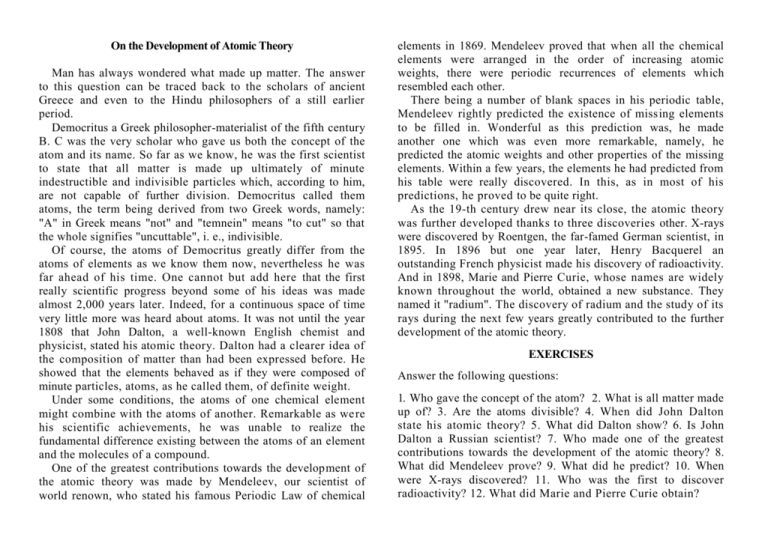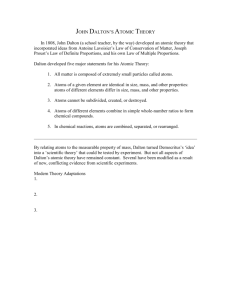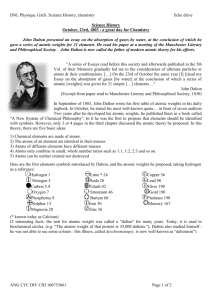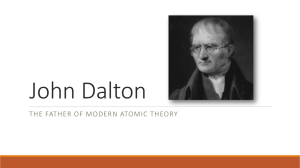On the Development of Atomic Theory
advertisement

On the Development of Atomic Theory Man has always wondered what made up matter. The answer to this question can be traced back to the scholars of ancient Greece and even to the Hindu philosophers of a still earlier period. Democritus a Greek philosopher-materialist of the fifth century В. С was the very scholar who gave us both the concept of the atom and its name. So far as we know, he was the first scientist to state that all matter is made up ultimately of minute indestructible and indivisible particles which, according to him, are not capable of further division. Democritus called them atoms, the term being derived from two Greek words, namely: "A" in Greek means "not" and "temnein" means "to cut" so that the whole signifies "uncuttable", i. e., indivisible. Of course, the atoms of Democritus greatly differ from the atoms of elements as we know them now, nevertheless he was far ahead of his time. One cannot but add here that the first really scientific progress beyond some of his ideas was made almost 2,000 years later. Indeed, for a continuous space of time very little more was heard about atoms. It was not until the year 1808 that John Dalton, a well-known English chemist and physicist, stated his atomic theory. Dalton had a clearer idea of the composition of matter than had been expressed before. He showed that the elements behaved as if they were composed of minute particles, atoms, as he called them, of definite weight. Under some conditions, the atoms of one chemical element might combine with the atoms of another. Remarkable as we re his scientific achievements, he was unable to realize the fundamental difference existing between the atoms of an element and the molecules of a compound. One of the greatest contributions towards the development of the atomic theory was made by Mendeleev, our scientist of world renown, who stated his famous Periodic Law of chemical elements in 1869. Mendeleev proved that when all the chemical elements were arranged in the order of increasing atomic weights, there were periodic recurrences of elements which resembled each other. There being a number of blank spaces in his periodic table, Mendeleev rightly predicted the existence of missing elements to be filled in. Wonderful as this prediction was, he made another one which was even more remarkable, namely, he predicted the atomic weights and other properties of the missing elements. Within a few years, the elements he had predicted from his table were really discovered. In this, as in most of his predictions, he proved to be quite right. As the 19-th century drew near its close, the atomic theory was further developed thanks to three discoveries other. X-rays were discovered by Roentgen, the far-famed German scientist, in 1895. In 1896 but one year later, Henry Bacquerel an outstanding French physicist made his discovery of radioactivity. And in 1898, Marie and Pierre Curie, whose names are widely known throughout the world, obtained a new substance. They named it "radium". The discovery of radium and the study of its rays during the next few years greatly contributed to the further development of the atomic theory. EXERCISES Answer the following questions: 1. Who gave the concept of the atom? 2. What is all matter made up of? 3. Are the atoms divisible? 4. When did John Dalton state his atomic theory? 5. What did Dalton show? 6. Is John Dalton a Russian scientist? 7. Who made one of the greatest contributions towards the development of the atomic theory? 8. What did Mendeleev prove? 9. What did he predict? 10. When were X-rays discovered? 11. Who was the first to discover radioactivity? 12. What did Marie and Pierre Curie obtain?










